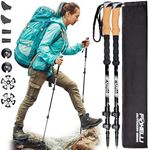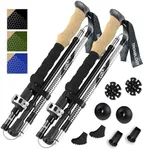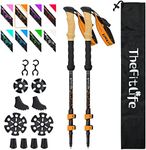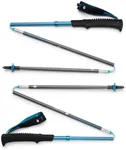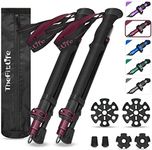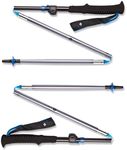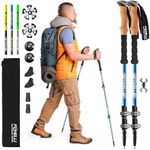Buying Guide for the Best Walking Poles
Walking poles are essential tools for hikers and trekkers, providing stability, reducing strain on joints, and enhancing overall balance. Choosing the right walking poles involves understanding various specifications that can affect your comfort and performance during your outdoor adventures. Here are the key specs to consider when selecting walking poles and how to navigate them to find the best fit for your needs.MaterialThe material of walking poles is crucial as it affects their weight, durability, and cost. Common materials include aluminum and carbon fiber. Aluminum poles are generally more affordable and durable, making them suitable for rugged terrains and heavy use. Carbon fiber poles are lighter and can reduce fatigue during long hikes, but they are typically more expensive and can be less durable. If you prioritize lightweight gear for long treks, carbon fiber might be the best choice. For more durability and budget-friendly options, aluminum is a solid pick.
AdjustabilityAdjustability refers to the ability to change the length of the poles. Adjustable poles are versatile and can be tailored to different terrains and user heights. They usually come in telescoping or folding designs. Telescoping poles are easy to adjust and are great for varying inclines, while folding poles are compact and convenient for travel. If you hike on diverse terrains or share poles with others, adjustable poles are ideal. Fixed-length poles are lighter and simpler but lack versatility, making them suitable for consistent terrain and personal use.
GripThe grip of walking poles affects comfort and control. Common grip materials include cork, foam, and rubber. Cork grips are comfortable, absorb sweat, and conform to your hand over time, making them great for long hikes. Foam grips are soft and lightweight, providing good comfort but can wear out faster. Rubber grips are durable and provide a firm hold, ideal for wet conditions. Choose cork for comfort and long hikes, foam for lightweight and short treks, and rubber for durability and wet environments.
WeightWeight is an important factor as it influences how easy the poles are to carry and use. Lightweight poles reduce fatigue and are easier to handle, especially on long hikes. Heavier poles can offer more stability and durability but may cause more strain over time. If you plan on long-distance hiking or trekking, opt for lighter poles to conserve energy. For shorter hikes or more rugged terrain, heavier poles might provide the stability you need.
Locking MechanismThe locking mechanism secures the pole at the desired length. Common types include lever locks, twist locks, and push-button locks. Lever locks are quick and easy to adjust, providing reliable security. Twist locks are lighter but can be less reliable in extreme conditions. Push-button locks are simple and effective but may add weight. If you need quick adjustments and reliability, lever locks are ideal. Twist locks are suitable for lightweight needs, and push-button locks offer simplicity and ease of use.
TipThe tip of the walking pole affects traction and durability. Carbide tips are durable and provide excellent grip on various surfaces, including rocks and ice. Rubber tips are quieter and better for paved surfaces but wear out faster. Some poles come with interchangeable tips for different terrains. If you hike on mixed terrains, carbide tips are versatile and durable. For urban or paved trails, rubber tips offer a quieter experience.
